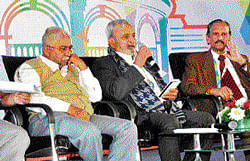
Mother Earth refused to take our dump. Landfills filled full and mountains of garbage threatened to flood back to drown us in our own muck.
Then Bangalore sat up and groaned under its load, implemented waste se-gre-gat-ion. The farmers around the landfills took up scythes and a desperate administration implemented desperate measures.
But inside homes, rubbish happened. On my floor alone there is a garbage thug that leaves it out in the common area each day, and has never been caught litter-handed. Can Houdini’s blood brother/sister be expected to comply as long as they can get away with trashing like this?
And here I am, with a pile of garbage, before disposal bins that are labelled Wet, Dry, Kitchen waste, Biodegradable and Not-that. Not-that is further split into — Recyclable, Toxic, Soiled. Why is the sanitary pad that the ad says always dry, not so? The food foil, the toffee wrapper, goes into Dry, but is not recyclable. I never messed with such, I swear.
The house-help, finding her position threatened, assumes authority and informs me that it is simply ‘kitchen waste’ and ‘all else’. So garden leaves, she says, is not kitchen waste but ‘all else’. If the discarded palak leaf is ‘kitchen waste’, how dare she discriminate against the fern. She challenges, ‘Eat and show?’ So I stuff the fern leaf — no, not in my mouth, but into another bag I call Moot.
When ‘foreign-returned’ talked of the pile up of junk ‘in foreign’, and said ‘in foreign’, they don’t repair, just ‘dispose off’ — cars, refrigerators of all things, everyone listened with wide-eyed wonder.
We had an army of grime-collared and amazingly efficient men who mended, oiled and painted to ‘brand new’ everything they could lay their dirty nails on. There were drycleaners who darned and dyed, repair guys that mended mixers, geysers, coolers, fans, even flasks; tailors and mothers came together to turn old sarees into jholas and cushion covers, faded sheets into mattress covers, which, by the way, weren’t foam or poly-fill but cotton that was beaten and fluffed out and added to when flattened out. Ditto with razais and pillows. Nothing had to be thrown away, shoe boxes were amassed for craft projects; fused bulbs carefully tipped out to grow money plants.
There were cows in the aangan to be fed the leftovers. The kitchen did not generate waste that could not be dumped in the garden to turn into compost. Frugality wasn’t frowned upon because nothing was two-minute. No snip of scissors produced ready-to-cook or to eat rice, curry, paste or puree in tetra or plastic packs.
When bitter gourd was served for dinner, we knew what was coming for lunch the next day — its skin. Milk came in glass bottles that had to be washed and exchanged for more. So did soft drink.
Birthday and other parties had people borrowing plates, spoons and glasses from neighbours. Wash and use was the mantra. One person was engaged to wash all evening for a continuous water-dripping stream of plates and spoons.
If the Sunday morning breakfast was to be got from the bazaar, steel tiffin carriers and dabbas were taken along, no eatery offered take-away plastic dabbas. Atta was stored in oil cans and dal in biscuit tins.
Pearlpets, Tupperwares shelved those out. Cling foils, bubble sheets, zip pouches — how much plastic, polythene that we cannot do without. Even our soap, shampoo and ointment look delectable in shiny plastic containers.
Waste people, all of us have become. Wait till ‘treating someone like dirt’ becomes a term of reverence.